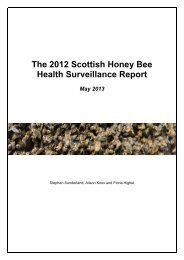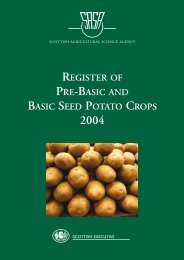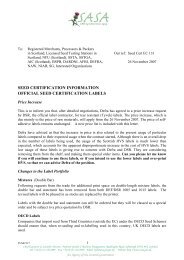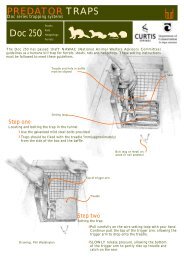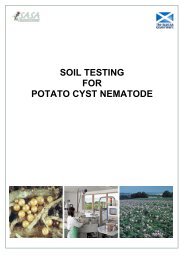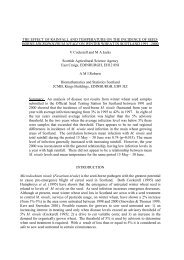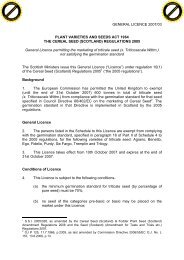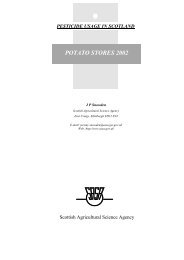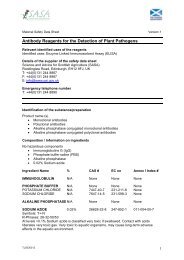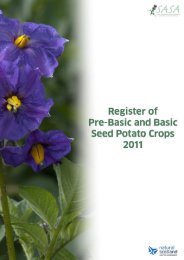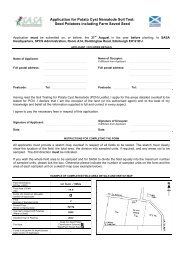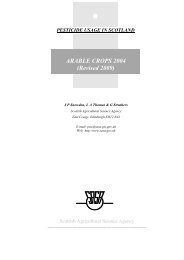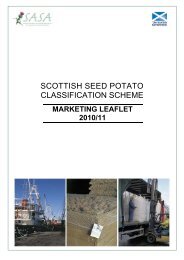IntroductionDenmark via Normandy and Brittany); itdiffused <strong>in</strong>to <strong>Scotland</strong> with <strong>the</strong> migration <strong>of</strong>Normans, <strong>in</strong>vited north by Scottish k<strong>in</strong>gswho were <strong>in</strong>tent on <strong>the</strong> Europeanisation <strong>of</strong><strong>the</strong>ir predom<strong>in</strong>antly Celtic country(<strong>in</strong>troduction <strong>of</strong> <strong>the</strong> Roman CatholicChurch; foster<strong>in</strong>g <strong>of</strong> trade and urbandevelopment; centralisation <strong>of</strong> authority).Under <strong>the</strong> evolv<strong>in</strong>g feudal system, parcels<strong>of</strong> land were granted <strong>in</strong>def<strong>in</strong>itely t<strong>of</strong>avoured <strong>in</strong>dividuals and <strong>the</strong>ir descendants,and to various <strong>in</strong>stitutions <strong>of</strong> <strong>the</strong> church.These grants were <strong>in</strong> return for acommitment to provide military support(men, arms and supplies) as required, butalso hospitality when <strong>the</strong> court or its<strong>of</strong>ficers were travell<strong>in</strong>g. Those who heldland directly from <strong>the</strong> crown <strong>in</strong> this way(<strong>the</strong> barons) were responsible for local lawand order, hold<strong>in</strong>g <strong>the</strong> power <strong>of</strong> life anddeath over <strong>the</strong> <strong>in</strong>habitants <strong>of</strong> <strong>the</strong>ir barony.The land could be repossessed by <strong>the</strong> k<strong>in</strong>gif <strong>the</strong> baron failed to perform;never<strong>the</strong>less, with <strong>the</strong> passage <strong>of</strong> time,barons came to consider <strong>the</strong>mselves asland owners, and a legal system developedto keep track <strong>of</strong> <strong>the</strong> buy<strong>in</strong>g and sell<strong>in</strong>g <strong>of</strong>land.Baronies varied enormously <strong>in</strong> size from afew hundred to many thousand hectares,and groups <strong>of</strong> baronies could be organised<strong>in</strong>to regalities held by major magnates.Normally, <strong>the</strong> baron was not actively<strong>in</strong>volved <strong>in</strong> agricultural production; hedistributed <strong>the</strong> land <strong>of</strong> <strong>the</strong> barony totenants (tackholders or tacksmen), <strong>in</strong> arange <strong>of</strong> legal arrangements, which, by <strong>the</strong>end <strong>of</strong> <strong>the</strong> seventeenth century, normally<strong>in</strong>volved a written legal contract, cover<strong>in</strong>gless than 20 years, which laid out <strong>the</strong>details <strong>of</strong> <strong>the</strong> rent to be paid (<strong>in</strong> <strong>the</strong> form <strong>of</strong>agricultural produce, pr<strong>in</strong>cipally gra<strong>in</strong>) and<strong>the</strong> services to be rendered (harvest labour,peat cutt<strong>in</strong>g, haulage, act<strong>in</strong>g asmessengers, ma<strong>in</strong>ta<strong>in</strong><strong>in</strong>g <strong>the</strong> barony mill).Later, tacks <strong>in</strong>cluded options for payment <strong>in</strong>cash. The tacksman could manage <strong>the</strong>land himself or sublet to o<strong>the</strong>rs, but <strong>the</strong>considerable amount <strong>of</strong> manual labourrequired for <strong>the</strong> exist<strong>in</strong>g agricultural systemwas supplied by numerous landless cottars.This form <strong>of</strong> land distribution led toseparate nuclei <strong>of</strong> settlement occupied bysmall groups <strong>of</strong> families (fermtouns), ra<strong>the</strong>rthan larger villages, except <strong>in</strong> <strong>the</strong> Merseand <strong>East</strong> Lothian. Under <strong>the</strong> feudal system,land was a source <strong>of</strong> subsistence andlabour for <strong>the</strong> baron and, ultimately, <strong>the</strong>k<strong>in</strong>g; it was not, primarily, a source <strong>of</strong> cash<strong>in</strong>come. There was no tradition <strong>of</strong> smallscalelandownership; even <strong>the</strong> smallerlandhold<strong>in</strong>gs which were created out <strong>of</strong> <strong>the</strong>great religious baronies at <strong>the</strong> Reformationwere largely re-absorbed by larger estates<strong>in</strong> subsequent centuries.The ImprovementsMuch has been made <strong>of</strong> <strong>the</strong> very primitivestate <strong>of</strong> agriculture <strong>in</strong> <strong>Scotland</strong> before <strong>the</strong>Improvements, and <strong>the</strong> role <strong>of</strong> <strong>the</strong> Union <strong>of</strong><strong>Scotland</strong> and England (1707) <strong>in</strong> promot<strong>in</strong>gagricultural progress. Recent historicalresearch has shown that this is asimplification; <strong>the</strong> records <strong>of</strong> gra<strong>in</strong> exportsto cont<strong>in</strong>ental Europe through east coastports <strong>in</strong> <strong>the</strong> seventeenth century show thatparts <strong>of</strong> <strong>the</strong> country were already wellabove <strong>the</strong> subsistence level, andimplement<strong>in</strong>g new knowledge from <strong>the</strong>Dutch as well as from England. A run <strong>of</strong>very poor harvests immediately before 1707has served to distort <strong>the</strong> record.Never<strong>the</strong>less, start<strong>in</strong>g around 1700 <strong>in</strong> <strong>the</strong>South <strong>of</strong> <strong>Scotland</strong>, and mov<strong>in</strong>g <strong>in</strong> anirregular wave through <strong>the</strong> lowlands, an“agricultural revolution” did reach mostparts <strong>of</strong> <strong>the</strong> North-<strong>East</strong> lowlands by around1820. The rate <strong>of</strong> change accelerated after1750. This revolution was facilitated bymajor changes <strong>in</strong> <strong>the</strong> legal system, <strong>in</strong> socialorganisation, and <strong>in</strong> national politics, whichtended to alter <strong>the</strong> world view <strong>of</strong>landowners; <strong>the</strong>y changed from be<strong>in</strong>g <strong>the</strong>11
<strong>Crop</strong> <strong>Production</strong> <strong>in</strong> <strong>the</strong> <strong>East</strong> <strong>of</strong> <strong>Scotland</strong>leader <strong>of</strong> <strong>the</strong> baronial community (<strong>in</strong>clud<strong>in</strong>g<strong>the</strong> role <strong>of</strong> dispenser <strong>of</strong> justice) to <strong>the</strong>controller <strong>of</strong> natural and human resourceswhich could be exploited for cash. TheImprovements <strong>in</strong>volved numerous changes,<strong>in</strong>clud<strong>in</strong>g:• direct <strong>in</strong>volvement <strong>of</strong> <strong>the</strong> owner or hisfactor <strong>in</strong> farm<strong>in</strong>g and farm management• reduction <strong>in</strong> <strong>the</strong> number <strong>of</strong> tenants• consolidation and rationalisation <strong>of</strong>hold<strong>in</strong>gs, and <strong>the</strong> creation <strong>of</strong> walls,fences and hedges to control livestock• division and enclosure <strong>of</strong> common land• technical advances <strong>in</strong> crop production(e.g. lim<strong>in</strong>g; <strong>in</strong>troduction <strong>of</strong> newrotations, featur<strong>in</strong>g new species such asturnips, pasture legumes and sowngrasses; improved varieties and seedquality; <strong>the</strong> change from grass-fed ox togra<strong>in</strong>-fed horse power; improvedimplements; some dra<strong>in</strong>age)• technical advances <strong>in</strong> livestockproduction, <strong>in</strong>clud<strong>in</strong>g better <strong>in</strong>tegration<strong>of</strong> crop and livestock production (e.g.improved breed<strong>in</strong>g; higher productivity;<strong>in</strong>troduction <strong>of</strong> forage crops, andconservation <strong>of</strong> grass as hay, permitt<strong>in</strong>goverw<strong>in</strong>ter<strong>in</strong>g <strong>of</strong> greater numbers <strong>of</strong>livestock; more, and higher-qualitymanure)Subsequent major improvements <strong>in</strong> <strong>the</strong>n<strong>in</strong>eteenth century <strong>in</strong>volved underdra<strong>in</strong>age,<strong>the</strong> use <strong>of</strong> imported m<strong>in</strong>eralfertilisers such as guano, and progressivemechanisation. Ano<strong>the</strong>r importantdevelopment <strong>in</strong> <strong>the</strong> seventeenth andeighteenth centuries was <strong>the</strong> reclamation <strong>of</strong>fertile coastal areas and carselands byextensive dra<strong>in</strong>age systems and <strong>the</strong>removal <strong>of</strong> vast quantities <strong>of</strong> lowland peat.Modern TimesThe Improvements laid <strong>the</strong> foundation for<strong>the</strong> major <strong>in</strong>ter-related features <strong>of</strong> Scottishagriculture <strong>in</strong> modern times: large units (byNor<strong>the</strong>rn European standards), low ruralpopulation, <strong>in</strong>tensive production systems(but with functional connections betweencrop and livestock production), and an<strong>in</strong>dustry tuned to national and world trendsra<strong>the</strong>r than local or subsistence priorities.The consolidation and rationalisation <strong>of</strong> <strong>the</strong>land with<strong>in</strong> large estates led to <strong>the</strong> rise <strong>of</strong> aclass <strong>of</strong> major tenants, farm<strong>in</strong>g areas <strong>of</strong> <strong>the</strong>scale <strong>of</strong> 40 hectares (100 acres),occasionally more, with a substantial stonebuilthouse and stead<strong>in</strong>g. These tenantspaid cash rents and marketed <strong>the</strong>irproducts <strong>in</strong>dependently. They had security<strong>of</strong> tenure and could normally pass <strong>the</strong>tenancy to <strong>the</strong> next generation. Dur<strong>in</strong>g <strong>the</strong>twentieth century, consolidation cont<strong>in</strong>ued,and a high proportion <strong>of</strong> <strong>in</strong>dividual farmsbecame owner-occupied: at <strong>the</strong> 1998agricultural census, <strong>the</strong> mean area <strong>of</strong> cropsand grass per hold<strong>in</strong>g <strong>in</strong> <strong>the</strong> study area was68 ha (170 acres) (see Tables 1.3 and 1.4).In <strong>the</strong> course <strong>of</strong> <strong>the</strong> eighteenth centuryImprovements, <strong>the</strong> rema<strong>in</strong><strong>in</strong>g tacksmen andcottars were relegated to <strong>the</strong> status <strong>of</strong> farmservants (engaged for periods <strong>of</strong> months,and housed on <strong>the</strong> farm) or day labourers.The fermtouns were largely destroyed <strong>in</strong><strong>the</strong> process <strong>of</strong> consolidation, anddisappeared entirely from <strong>the</strong> landscape; <strong>in</strong>some areas, even <strong>the</strong>ir names have beenforgotten. They were replaced by sufficientcottages to house <strong>the</strong> labourers required by<strong>the</strong> farm. This pattern was not uniformthroughout <strong>the</strong> area. For example, <strong>in</strong> <strong>the</strong>North-<strong>East</strong>, it was common for improv<strong>in</strong>glandlords to create small hold<strong>in</strong>gs at <strong>the</strong>boundary <strong>of</strong> <strong>the</strong> <strong>in</strong>tensively-managed land;tenants were <strong>of</strong>fered generous <strong>in</strong>itial termsto <strong>in</strong>duce <strong>the</strong>m to br<strong>in</strong>g <strong>the</strong> land <strong>in</strong>tocultivation. In <strong>the</strong> n<strong>in</strong>eteenth century, <strong>the</strong>re12



